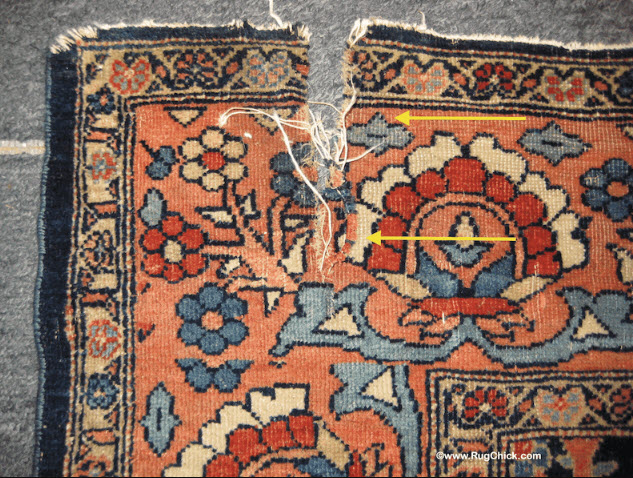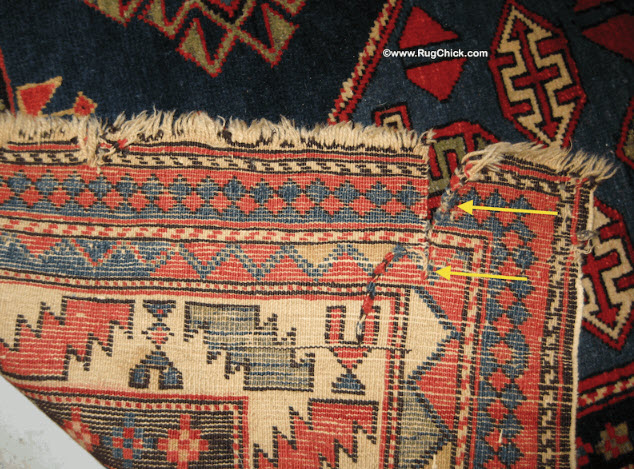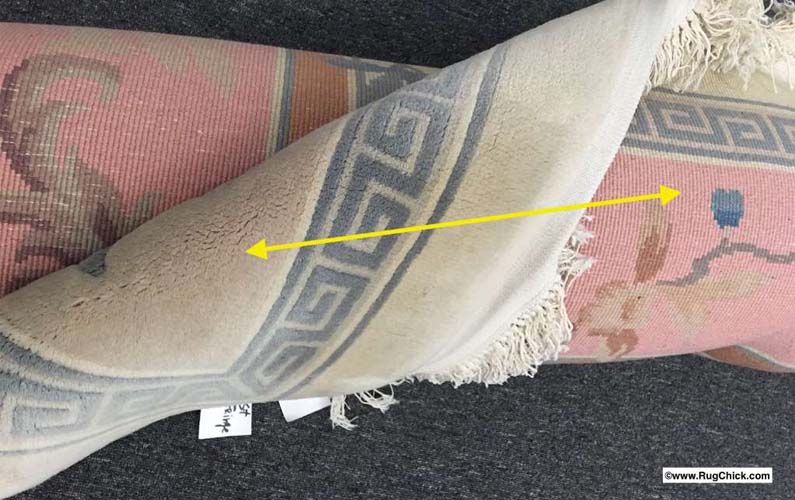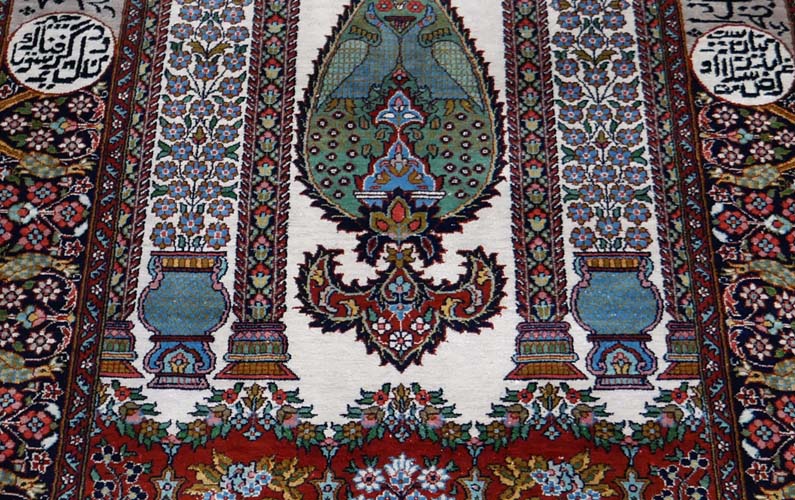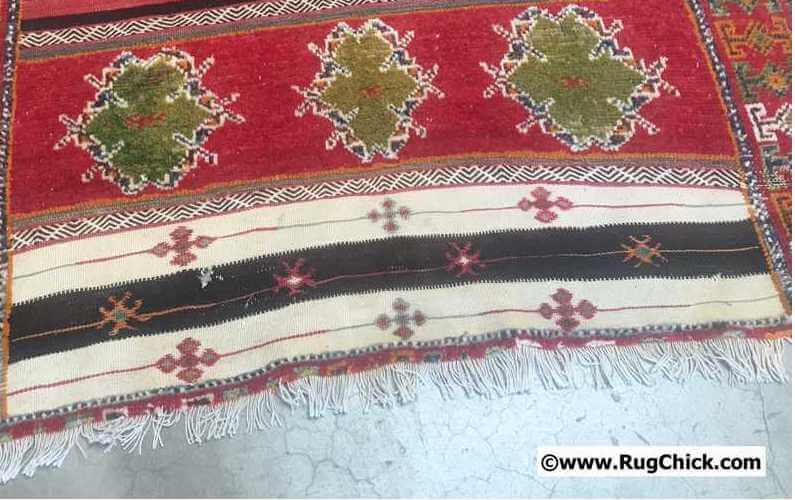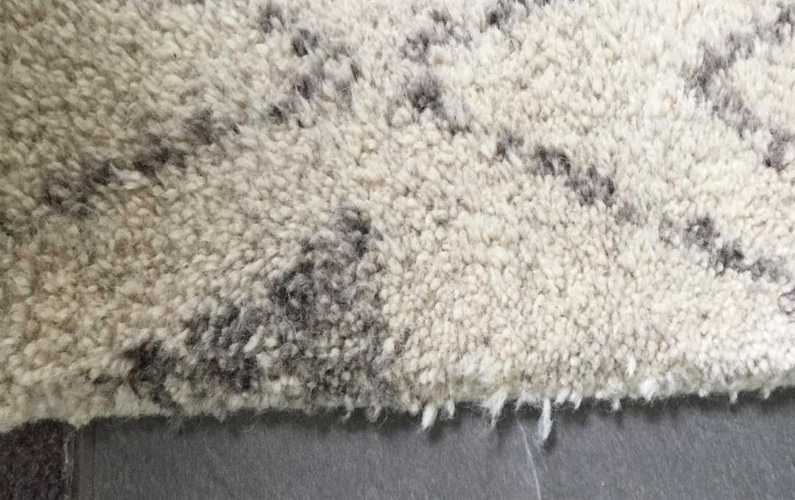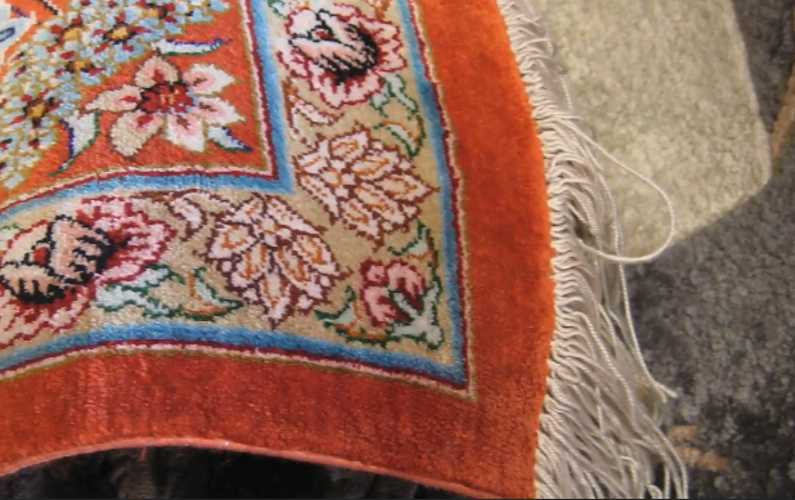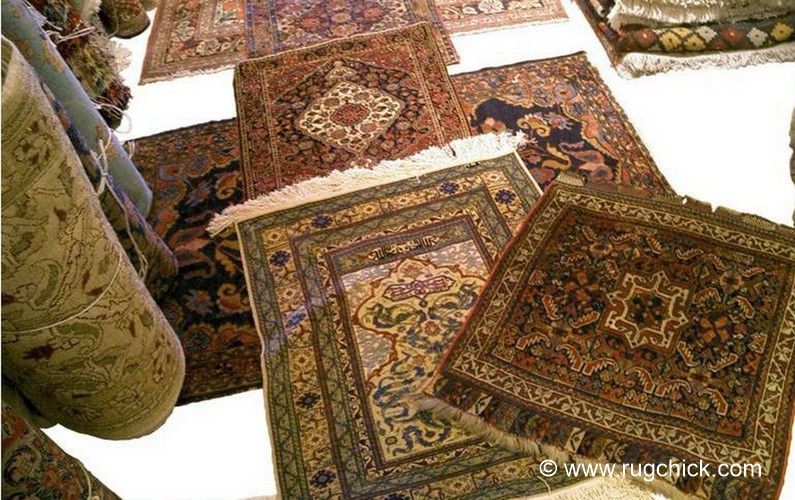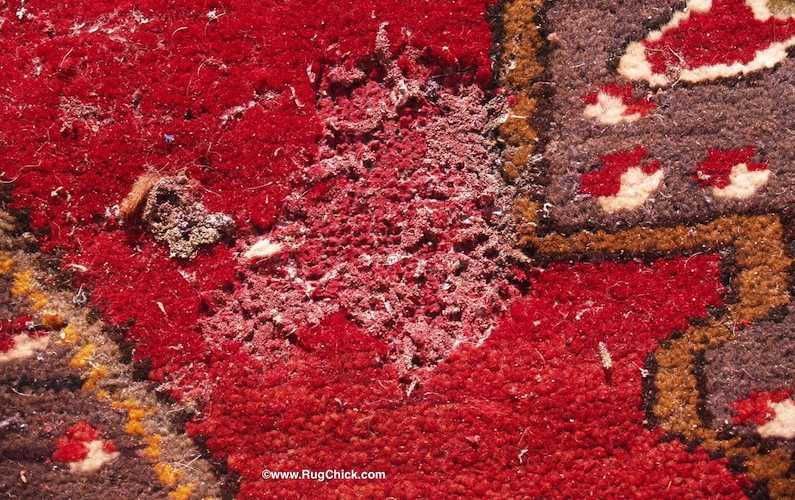Mold and Dry Rot in Rugs
There is a fungus among us…
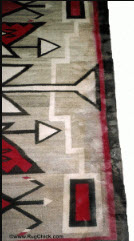
Water damaged Navajo rug has mildew growing on it.
and there is nothing “fun” about it.
One of the worst conditions that can befall a rug is DRY ROT.
Mold, mildew, and dry rot are various types and stages of particular fungi. Where you can sometimes kill and remove the first two groups without much evidence left behind in a rug (if you get to it relatively early), when you get to the dry rot stage in a rug, there is no turning back.
Dry rot in a rug is the deterioration of the foundation fibers, usually cotton but sometimes wool, jute, or silk. In the extreme it is a total lack of structural integrity and to a rug this means it can simply fall apart.
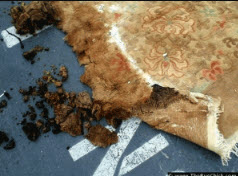
Dry rot of this rug has led to total destruction of the textile.
There is no fixing this.
The problem with dry rot is that it is usually discovered too late to undo the damage, so let’s talk about what creates this condition, what to be on the look out for, and what to do when you discover a rug has a mildew, mold, or dry rot issue.
DRY ROT: What Causes It?
The cause of fiber deterioration is the extremes of too much moisture, or too little of it.
You can see damage set in from moisture due to floods, leaks (from plants), or high humidity with a lack of evaporation due to a barrier such as plastic mat covering a wool rug or a rug wrapped in plastic wrap.
(By the way, those plastic covers used to roll your chair on top of are HORRIBLE for being placed over wool rugs, you will have a mildew problem over time, and little holes etched into the fibers from the underside of those protective mats. Also, wool rugs should be wrapped in paper, not in plastic, as this also can lead to a musty/mildew odor over time.)
Pets are also a cause of dry rot, as pet urine salts can keep those innermost cotton foundation fibers moist for a much longer time than plain water can, and there is a tendency to create stiff, rotten areas as a result.
You also see damage set in from age, or a build up of cleaning residue that is drying to the fibers. We see this especially in rugs that are not rinsed properly, and it is a primary reason why rugs are not to be cleaned in the home. You can see brittleness due to high heat or direct sunlight conditions over time as well (similar to how your drapes can sometimes shred apart from sun exposure).
A final cause of fiber deterioration is the use of whitening chemicals (such as bleaches and peroxides). We especially see this in cotton fringes that become easy to tear away the tassels due to a lack of fiber strength from this chemical damage.
DRY ROT: What To Look Out For.
One of the first things to be on the look out for is any discoloration on a rug, especially moldy looking areas.
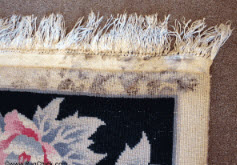
Mold and dry rot activity is usually more noticeable on the back side of the rug than the front.
If there is any type of water source near a rug you want to look for evidence of any problems. Potted plants, water coolers, pet water dishes, or any slab leaks over time can contribute to the growth of mildew and eventually dry rot.
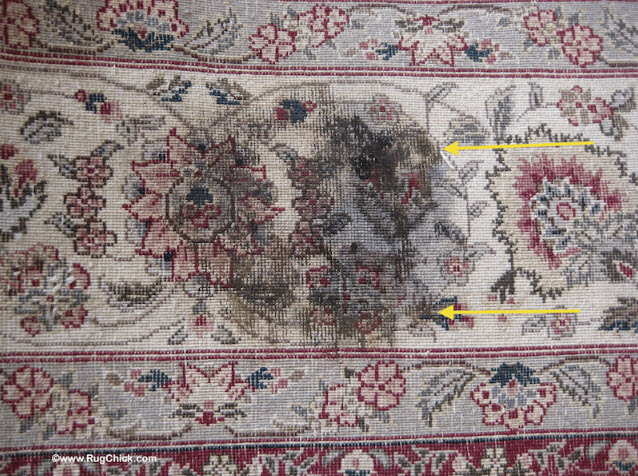
Wool rug with cotton foundation fibers. A potted plant created this ring of mold and dry rot visible on the back of the rug. This area will feel VERY stiff to the touch.
Once mold root systems get into the inner foundation fibers it is next to impossible to strip those away to remove these black/dark discolorations. If the area is stiff to the touch and cracks when you slowly bend it, or it sounds like wood when you knock on the area with your knuckles, then dry rot has set in and you have to be incredibly careful so that you do not create a hole like this:
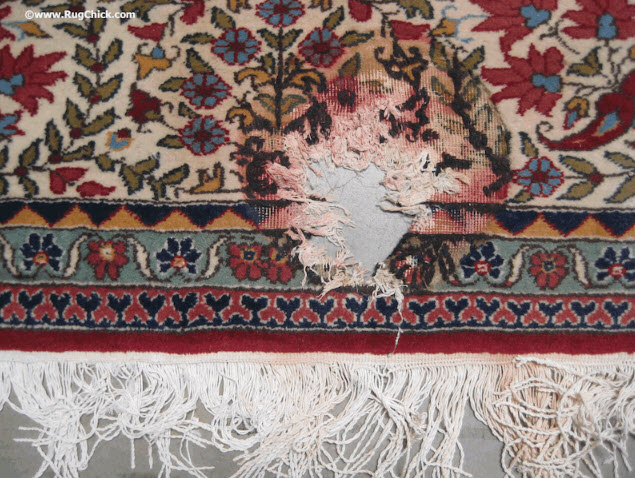
A hole is what eventually happens when dry rot is left alone to do its dirty work.
Though this is usually a problem we see with rugs that have a cotton foundation, it is possible for dry rot to deteriorate wool rugs woven on wool warps and wefts if it is left wet for months.
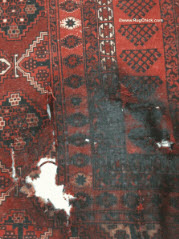
Wool on wool Turkoman rug with potted plant damage. Dry rot is so black that it looks as if the rug has been burned.
You also want to be on the look out for pet urine damaged areas. These will likely be yellow discolorations on the top side of the rug, like this:
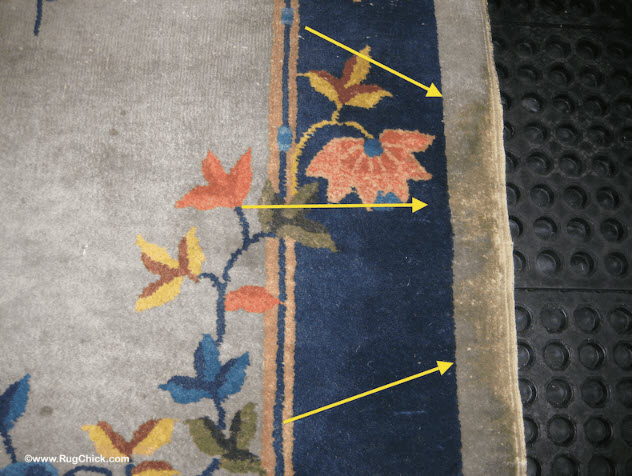
Pet urine activity over months and months has completely discolored the side of this Nichols Chinese rug. This area is very brittle and stiff to the touch, indicating that the cotton foundation fibers that the wool knots are tied around are rotten.
Pet activity over time can be devastating to a rug, not only in terms of dye damage and discoloration, but also in weakening the foundation fibers. The “skeleton” of the rug essentially crumbles apart.
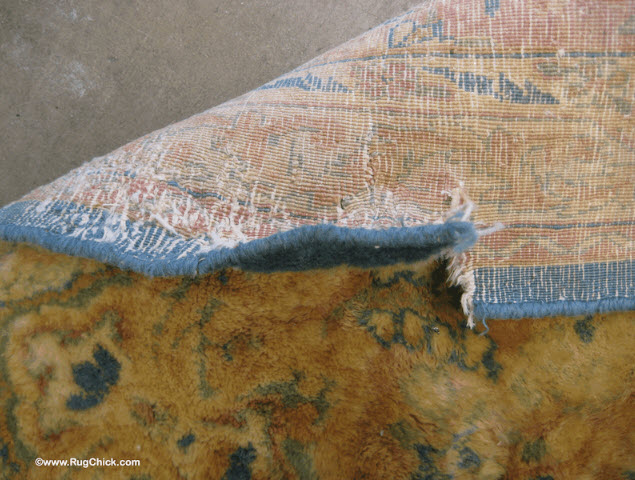
Pet urine damaged Kerman rug has torn.
Without the more obvious visual signs of dark discolorations, or pet damage, you sometimes have to rely on your hands to find the warning signs.
With semi-antique and antique rugs, fibers can become weaker and brittle due to age. You do not want to haphazardly bend areas of an old rug to see if the foundation fibers crack. Instead you want to look for signs of splits in rugs that can give you clues about possible signs of dry rot or brittleness preceding the most devastating phase of widespread deterioration.
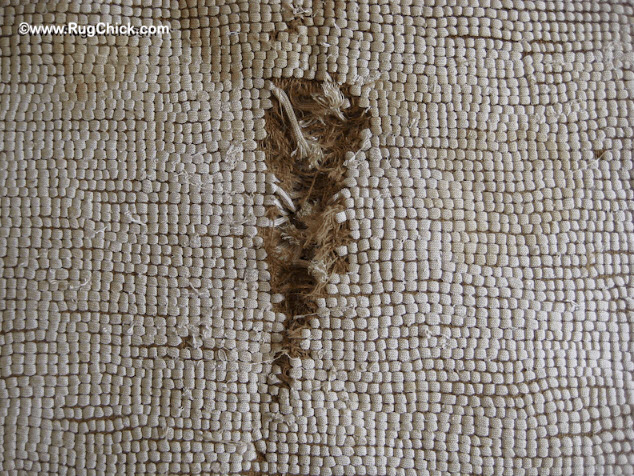
Jute and burlap becomes exceptionally brittle with age. This rug is from the 1940’s, and the jute foundation has split in the middle.
Because the sides and ends often get a bit more wear and tear than the middle of a rug, you can usually find splits and cracks to serve as your warning signs.
Aggressive chemical use, or build up of chemical residue, can dry out foundation fibers and make them brittle and eventually rotten. We especially see this on cotton fringe that has been made super white by the rug manufacturers.

White cotton tassels have gotten so weak they have torn away completely from the end of this rug.
Just like when you bleach cotton t-shirts too many times and they begin to shred apart, this also happens with cotton fringes. Rugs from China, India, Pakistan, and Iran all can have this type of damage.
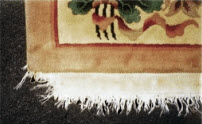
Too much hydrogen peroxide use on this rug over the years to keep the fringes white. Chlorine bleach, oxygen bleach, and other whitening solutions all cause different levels of damage to cotton fringe fibers.
When you are inspecting the rug, tug on the cotton tassels and see if they break away easily. The cotton should be strong enough to not break, but if it pulls away like hair, or snaps off easily, then you know you have weakened cotton to deal with in your cleaning process.
Many newer rugs have this problem (because people like WHITE fringe), and many older rugs have little or no fringe because their tassels have already broken away after 75+ years on the floor.
DRY ROT: What To Do When You Find It
1. DOCUMENT
The first thing you do when you discover signs of mildew, mold, or dry rot is document it. Take photos and indicate the condition on your invoice or pre-wash inspection sheet.
2. COMMUNICATE
The next step is to share the condition with the owner of the rug. If the problem is due to isolated water exposure, such as a plant or pet, make them aware of the damage caused and that this has already devalued the rug as a result.
If dry rot has set in, you need to explain that this is permanent damage that is not reversible, and that you cannot be held liable if the worst areas become splits or holes during the cleaning process. Lay out realistic expectations. Secure weak areas if necessary for the wash process.
3. HELP IF YOU CAN
If the rug has mildew/mold you can use sanitizing or disinfecting solutions to stop this damage from continuing. Check your cleaning suppliers for approved solutions in your state.
With dry rot, the deterioration “disease” itself is not reversible, but the symptoms of stiffness and cracking can be lessened. Petroleum based products can help soften rugs that have become brittle with age, some rug cleaning plants use denatured alcohol to help soften rugs and fabrics that have become stiff.
There is a new host of keratin products that also can add sheen and suppleness to rug fibers, not just to the cotton fibers, but also to wool and silk.
If you are familiar with women’s hair products being used today to help soften and strengthen chemically damaged or “more mature” hair, then you will understand how these products work with chemically damaged wool rugs, or those textiles with brittleness due to age.
As with the hair treatments, you cannot regenerate what has already been lost, but you can help the conditions be more friendly – and stronger – to everyday use. It is temporary help that requires continual treatments for upkeep, which can be costly but if you love your rugs as you love your hair, you might be willing to invest in this to help enjoy the textile longer.
One danger is that these solutions may give the impression that a rug is in much better condition than it truly is, just as great colored and conditioned hair can make someone look younger than they are, so if you are looking to invest money in an antique rug and it looks too good to be true – and has a high price tag on it – you should have a licensed appraiser inspect and evaluate the textile to verify that you are indeed acquiring a rug that will have longevity and retain its value.

If you are paying less than $30 per sq. ft. for a wool woven rug, and you really like it, there is no need for the second opinion. Once you hit about $30 and head up to hundreds per sq. ft., then it never hurts to seek out the licensed appraisers in the rug field. Just make sure you have one recommended to you because for every outstanding appraiser I know in the rug world, there are three others that are full of malarkey.
If you would like some basic tips on what to look for when buying rugs, I have a very detailed post on Rug Tips For The Nervous Rug Shopper – print that out and take it on your next rug shopping spree. =)
What about rotten fringe?
If the dry rot you find is not on an older rug, but on a newer one, and particularly on the fringe, then you have to explain to the owner why this is happening.
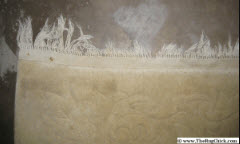
Cotton fringe is tearing off of this Chinese wool rug due to past chemical whitening.
You have to be careful when cleaning these tassels, because even the most gentle scrubbing will tear away fibers. Often the best solution is to place a new fringe over the top of the original damaged tassels.
On contemporary rugs, which rarely have fringe that adds any value to the rug itself (it is just a structural byproduct), it is not uncommon for prefabricated fringe to be tacked to the top side of the damaged fringe in order to cover it up and give the look of undamaged fringe.
There are ways to do this so that it does not look like brand new fringe on a not-brand-new rug. What is nice is that it is covering – and protecting – the weaker tassels from additional damage. Because these tassels are the warps that the wool knots are tied around, this keeps the rug from unraveling due to the continuing loss of its tassels.
If the “new” fringe is sewn to the rug by hand, as opposed to doing so by machine (or worse, with glue!), it is not creating anything that cannot be undone in the future. This is the least invasive way to solve the problem of bad looking fringe.
So, inform the rug owner about the weakness of the fringe, take care in getting it cleaner, and offer new fringe if that seems like the best option.
I hope you have enjoyed this post on dry rot, and that it helps you educate your clients to keep them from having to deal with this type of damage to their rugs.
Happy Rug Cleaning!
Lisa
P.S. I am currently accepting applications for our next team of Textile Pros, which will be chosen by August 20th. Jim Pemberton and I train with 20 companies over 6 months on rug and fine fabric care in a combination of on-line and in-person instruction. This is an advanced course for those who want to become specialists in this field. If you would like more information about the Textile Pro program, and an application to be considered, please email my team at TextilePros@gmail.com.

